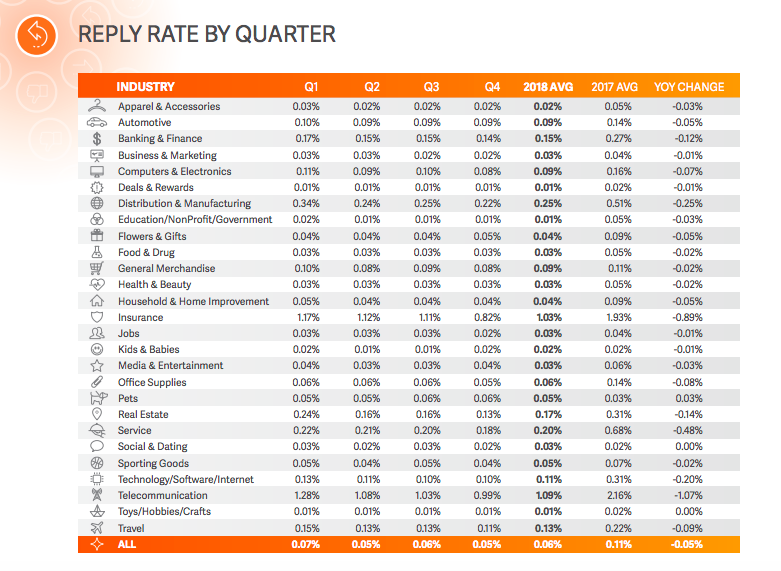
You might be asking yourself, “what is the reply rate and why should I care”. Well, as opposed to open and click rate, reply rate tracks how many recipients were interested enough to actually write you back and respond to your email. From a mailbox providers perspective, a reply to an email message is a strong positive signal of engagement from the subscriber, showing mailbox providers that your message was indeed desired. This can help improve future chances of being delivered to the inbox and not to the spam folder.
Calculating the reply rate is fairly simple: take the number of total replies to your email out of the total of email sent. A high reply rate could mean one of two things: an engaged subscriber list or subscribers trying to unsubscribe. There actually isn’t a target “reply rate” that your email marketing program should try to achieve. Having a low—or no— reply rate won’t necessarily hurt your deliverability, but having a high reply rate can certainly help.

You may be thinking “Okay, but my campaigns are not intended to be responded too. Does this mean I have to change my entire campaign to increase my reply rate?” The answer is, it really depends on your industry, subscriber base, and future goals, however, most promotional campaigns are created for subscribers to click on links to your online store or to seek further information. It’s always your subscribers choice whether they want to reply or not. We don’t suggest email marketers try anything gimmicky to increase their reply rate, instead, it would be better to change your “noreply@” address to a reply-to address that is monitored.
What is a Reply-To address?
A reply-to address is the email address that receives messages sent from those who select “reply” in their email clients. This address may differ from the “from” address, which can be an automated or un-monitored email address used only to send messages to a distribution list. The reply-to address should always (always, always) be monitored for incoming email. Subscribers who choose to reply to your emails can provide you with valuable information including insights and feedback. You could even segment the subscribers who respond to your emails and create a new segmentation to enhance your email marketing program.
Reply to or ‘noreply’? That is the question
Mailbox providers do not have any filtering rules set up to place your email into the spam folder if ‘noreply’ is used. However, using ‘noreply’ in your sending or reply-to address could harm deliverability through higher complaints, unsubscribe requests, and lower subscriber engagement due to poor customer experience. Mailbox providers will always look at your domain and IP address reputation when they are making those important filtering decisions, so it might have a more positive impact to encourage engagement from your subscribers as much as possible.
If you use a ‘no reply’ sending or reply-to address in some of your email, ensure that you are also including information or directions about how a subscriber can get support or service from you. If your subscribers are well informed about how to contact you, then using ‘no reply’ is likely to have no impact on your deliverability. However, using ‘no reply’ in your sending or reply-to address is not recommended because it tells a subscriber or customer that you aren’t interested in speaking with them, which can affect your brand image.
It might also happen that your subscribers don’t notice the ‘no reply’ address when they do reply or they don’t understand that you are asking them to not send them a message. If they reply and don’t hear back from you, they may perceive the experience as bad customer service—and we definitely don’t want that. A subscriber might also send you an unsubscribe request via email. It is your responsibility to honor all unsubscribe requests, otherwise, future emails may be marked as spam. If you are using a ‘no reply’ address that is not monitored your subscribers’ request will most likely never be processed.
Sooo…Did you get my email? – tips on getting a reply
Start by stepping into your subscribers’ shoes. Everyone knows that receiving random outreach emails from strangers can be somewhat unpleasant; it can be annoying even for those who are working in the email industry, right?. This will involve testing and personalization, compelling subject lines, as well as time and effort.
Start with defining your call-to-action! On average, subscribers spend six seconds reading an email. As great as your content may be, your subscribers need to understand your message quickly. Ensure your subject line is compelling for your subscribers to open the email and then the content of your email to have a clear action for the subscriber, in this case: replying to your email!
A great way to test and ensure your content is rendering perfectly on multiple devices before sending out that important campaign to your customers is through Return Path’s Inbox Preview solution. When you’re in Inbox Preview, take time to read through your email on a mobile device for example and see how long it takes you (or a colleague) to understand what the email is asking you to do. If it is not clear to you, it won’t be clear for your customers either.
As an example, theSkimm, a daily newsletter email, welcomes new subscribers who recently signed up and asks their subscribers to email them for feedback. It not only sends a signal to their subscribers that they are very welcome, it creates that meaningful connection with subscribers showing them that their feedback is important and at the same time encouraing them to reach out and reply – increasing your reply rate and engagement.

In another example from a Kate Spade campaign we can see how rewards encourage subscribers to reply. So if you want your subscribers’ opinion, give them a reason to give you valuable information! Feedback email response rates increase by 30% when incentives are included. You already have subscribers who want to give you feedback on your latest products and sharing insights on what they would like to see from your brand. Once you find those subscribers, reward them for their feedback. Reward offers can include gift vouchers, short-term discount codes, physical products or a chance to win a bigger prize (ie: car, lottery, voucher).

And sometimes is just about making sure that your subscribers have received your email and have had the opportunity to connect with you, as we can see in the following example from The Hustle:

So why encourage your subscribers to reply to your emails?
As we already learned, a reply to an email is a strong positive signal of engagement from the subscriber, showing to Mailbox Providers that your message was indeed desired – improving future chances of being delivered to the inbox. Increased engagement helps your emails reach the inbox of your subscribers, so take steps to encourage your subscribers to reply using email. ‘Nothing will come of nothing.’ (King Lear Act 1, Scene 1)